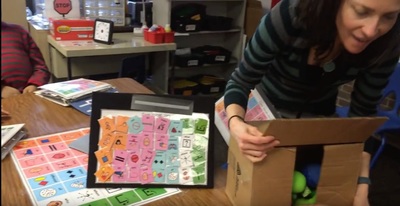Partner Skills: Creating Opportunities

Joint Activity Routines
Joint activity routines (JARs) are powerful teaching activities used to help beginning communicators develop and initiate language. JARs are brief (5 minutes) repetitive, interactive activities built around a specific communicative target.
To design a JAR, begin by identifying the repeated or "target" message. This word/phrase and correlating action gets repeated over and over throughout the middle of the activity, establishing a routine and providing multiple opportunities to model and use the target message. Once multiple models are given, provide opportunities for the AAC user to participate and express the target message.
Teaching, Not Testing
If the AAC user is having difficulty using the target message even after the routine has been established, use these teaching strategies to help them initiate use of the language target.
- Add a skilled AAC partner (i.e. co-teacher, paraprofessional, fluent AAC user) who will participate by modeling accurate use of AAC to express the target message in the routine. This provides a different model when the learner is not participating or responding, and often increases motivation when the other participant receives the desired item/action.
- Use recasts. When the AAC user responds incorrectly, say the corrected phrase conversationally.
- Use expansions. When the student gives a partial target, the adult says the full target. “Oh, you WANT a turn!”
- Acknowledge attempts. Interpret what you think the AAC user means to say, model it, and wait for clarification. “I think you want to tell me: “want it”, or "want turn."
- Provide more models.
- Reflect on the level of engagement and modify the routine as needed.
Keep a Successful Routine Exciting
Once the joint activity routine is established and the learners are independently expressing target messages, create new opportunities to develop language by disrupting the routine.
Pause/Interrupt
Use a time delay by doing only part of the routine and then wait for the AAC user to initiate the complete message.
Add New Steps or Levels of Detail in the Routine
Once the AAC user is fluently initiating the target message in the routine, move on to target new vocabulary, new communication functions, or new levels of complexity. Add to or modify the established routine by modeling a new target and repeating that message over and over. For example, an initial JAR might involve rocket balloons and the target message "go" to request the action of letting the balloon fly around the room. Once the user consistently initiates "go" in the routine, the partner might add the step of modeling "open" before opening the container of balloons. The original routine would remain the same, but the step of opening the jar would allow the AAC user opportunity to request another action and grow their vocabulary.
Explicitly Debrief Communication Breakdowns for Clarity
It is not uncommon for communication to break down, especially when learning to use AAC. Messages will be missed and misunderstood. Activities and actions will be completed out of sequence or differently than expected. Be alert and aware of communication breakdowns and repair by acknowledging the message that they have communicated (e.g. I see you are sad because the balloon popped and scared you. I think you want to be "all done" with balloons).
Commenting
Commenting is a powerful communication function that AAC users can use to express their thoughts, feelings, and opinions. AAC partners can model commenting easily and naturally during established scheduled activities and during explicit vocabulary instruction times. Provide time and space for AAC users to practice making comments following the models.
Examples of Commenting
- Choose a stem like "I see _," to model comments during a structured activity like a science experiment.
- Model character observations while reading a text with messages like "He is (VERB+ing)," and "She is (VERB+ing)" while pointing to pictures.
- Express personal feelings during discussions by modeling "I like _," and "I do not like _," being sure to use facial expression and vocal tone to increase authenticity.
- Take advantage of unexpected events by naturally expressing comments like "I do not like that! "I feel mad!" When I feel mad I can (appropriate action)." Providing these moments of instruction can support more appropriate expression of feelings versus use of undesirable behaviors.
Additional Ideas and Resources for Commenting
- Write comments about a story/text on sticky notes and stick them directly on the page as a reminder/support for you to model.
- Target comments using animated short videos.
- Also model commenting by using PlayPosit to add places to pause the video and a script for your comments.